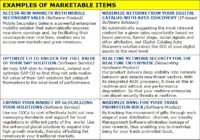As SAAS gains traction, software companies are making greater use of inside sales.
According to Salesforce, inside sales is growing 300% faster than outside sales. With more and more sales development representatives fishing in the same pond, the market is getting crowded.
As a result, inside sales is finding it ever harder to get through to prospects.
 Some vendors empower their SDRs by using Marketable Items and Account Specific Point Offerings to transform their messaging from product-out to business-in mode in order to win.
Some vendors empower their SDRs by using Marketable Items and Account Specific Point Offerings to transform their messaging from product-out to business-in mode in order to win.
Whereas others leave it to their SDRs to stumble through the challenge by themselves.
When that happens, SDRs are known to adopt immature and questionable tactics. These include feigned concern, guilt trips, impatience, strong-arm shaming, and other tactics described in The Pathetic State of B2B Market and Sales Development Tactics.
We’d never permit any of our SDRs to use the shady tactics described this article. We also agree with the author of this piece about the need for professionalism in Inside Sales (like in any other profession).
However, we felt that the concerns raised later in the article were somewhat pedantic in the context of inside sales in the B2B technology space.
Any veteran sales or marketing leader will easily be able to rebut them:
 Q1. Are these tactics really the first impression B2B managers want to create with customers?
Q1. Are these tactics really the first impression B2B managers want to create with customers?
A1: When an SDR predicts the reason why the prospect hasn’t responded, s/he is obviously doing a follow up. The first impression has already been created by the previous interaction(s). Therefore, this tactic doesn’t have any role to play in shaping the first impression.
Q2. Are these “hacking” techniques worth damaging a potential relationship?
A2: To be honest, there’s no relationship worth talking about with a prospect who hasn’t replied to your emails or taken your calls. Ergo, your SDRs won’t damage anything by doing a bit of hacking.
Q3. Do these tactics identify the customers that are ready to engage? Or do they deter people from even wanting to talk?
A3. Yes . No. Prospects are tired of the same approach followed by all vendors. A slightly different approach does work more often than you think. A customer of ours in the USA told us that he receives at least five cold emails a day. He averred that he reads beyond the first paragraph of a cold email only if he spots something new in it. Ditto with the two cold calls he receives a day.
Inside Sales is a tough job. The function faces a few unique challenges such as high rejection rates, need for twenty-something SDRs to connect with CxOs of FORTUNE 500 companies, need to work in night shifts, and so on. These are not faced by any other function in a typical software products or services company. Therefore, we shouldn’t be tacking on imaginary concerns on top of these hardships.
Instead, we should look for ways to unshackle SDRs and make them more aggressive.
The first step in doing that is to realize that SDRs enjoy a few advantages:
- They work at the top of the funnel, where interactions are ephemeral, and
- Suspects have fleeting memory.
This lets inside sales try out unconventional tactics. Don’t stop them.
We must hasten to add that the aforementioned concerns become real once a lead reaches the middle of the funnel. As an SQL (Sales Qualified Lead), the lead would be owned by field sales, account managers, and relationship managers and require to be treated with kid gloves. Unconventional tactics should be avoided at this stage. As Sabrina Ferraioli points out in B2B Phone Sales Tips: Beating the Voicemail Gatekeeper,
If you have 25 to 50 highly targeted, marketing qualified leads (MQL), inside sales can turn prospects into sales qualified leads (SQL). And if you turn even two or three SQLs into clients, you can have a substantial impact on your bottom line. So treat each one like gold.
But that shouldn’t stop you from unshackling SDRs operating at the top of the funnel to be more aggressive and try out new ways to get through to prospects.
